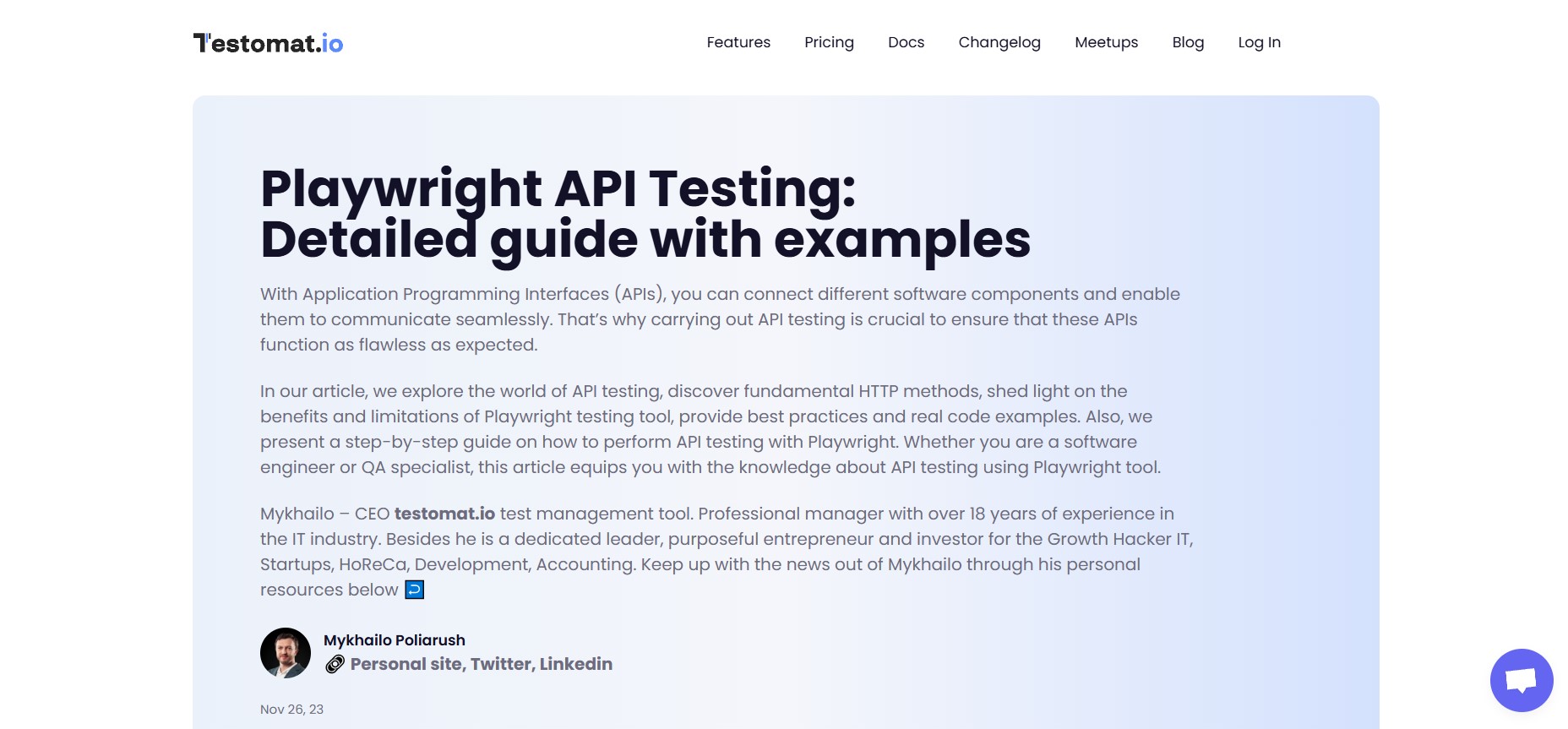Playwright API: Comprehensive Guide to Master API Testing with Playwright

Strong 8k brings an ultra-HD IPTV experience to your living room and your pocket.
In today's fast-paced software development world, ensuring that your APIs function correctly and reliably is essential. Automated testing plays a vital role in maintaining the quality and performance of web services and applications. One of the most powerful and versatile tools for modern automated testing is Playwright. In particular, playwright api testing is gaining momentum as an efficient, flexible, and developer-friendly approach to verifying backend services.
This guide explores everything you need to know about Playwright API testing, including its advantages, core concepts, practical examples, and best practices. Whether you're a seasoned QA engineer, a developer wanting to improve your testing workflow, or a test automation enthusiast, this comprehensive overview will help you unlock the full potential of Playwright for API testing.
## What Is Playwright API Testing?
Playwright is an open-source Node.js library developed by Microsoft that enables browser automation and end-to-end testing across multiple browsers such as Chromium, Firefox, and WebKit. While Playwright is primarily known for UI testing, its robust API testing capabilities are often underestimated.
**Playwright API testing** refers to the process of validating backend APIs directly by sending HTTP requests and verifying responses without relying on the UI layer. Unlike traditional UI testing, API testing focuses on the logic, data, and communication between client and server, which makes tests faster, more reliable, and easier to maintain.
With Playwright, you can create and run API tests alongside your UI tests in the same framework, using a consistent API and tooling. This integration provides a seamless testing experience, reducing context switching and enabling comprehensive coverage.
## Why Choose Playwright for API Testing?
There are several reasons why Playwright has become a preferred choice for API testing in modern development pipelines:
* **Unified Testing Framework:** Playwright allows you to test both the UI and API within the same project, simplifying your test architecture and tooling.
* **Cross-Browser Support:** Although API tests are browser-independent, Playwright’s extensive browser support gives you flexibility if you need to combine API and UI scenarios.
* **Powerful Request Interception:** Playwright lets you intercept, modify, and monitor network requests, making it easy to test edge cases and mock API responses.
* **Parallel Execution:** Playwright supports parallel test runs, speeding up your CI/CD pipeline and increasing test efficiency.
* **Rich Assertions and Debugging:** Built-in assertion libraries and detailed error reports help identify issues quickly during API validation.
* **Excellent Documentation and Community Support:** Playwright offers comprehensive guides, active community forums, and continuous updates to keep you on the cutting edge.
For a deeper dive into Playwright API testing techniques with real-world examples, check out this detailed resource: [playwright api](https://testomat.io/blog/playwright-api-testing-comprehensive-guide-with-examples/).
## Core Concepts in Playwright API Testing
Understanding the key components and workflows of Playwright API testing helps you build robust, maintainable tests. Here are the fundamentals:
### 1. Creating API Requests
Playwright provides the `request` API to create and send HTTP requests (GET, POST, PUT, DELETE, PATCH). You can set headers, query parameters, cookies, and request bodies easily.
Example workflow:
* Instantiate a new APIRequestContext.
* Send a request to the target endpoint.
* Await the response for validation.
### 2. Response Validation
After receiving the API response, Playwright enables you to validate:
* HTTP status codes (200, 404, 500, etc.)
* Response headers
* JSON/XML response bodies
* Specific data fields using powerful assertions
### 3. Authentication and Authorization
Testing secured APIs is simplified by managing authentication tokens, cookies, or OAuth flows within your Playwright tests. You can programmatically set tokens in headers or handle login flows to ensure your API endpoints are protected and behave correctly.
### 4. Mocking and Interception
Playwright’s request interception capabilities allow you to:
* Mock API responses for testing error handling and edge cases.
* Modify requests or responses on the fly.
* Record network traffic for debugging.
### 5. Test Isolation and Parallelization
Each Playwright test can have its own API context, ensuring isolation and eliminating side effects. Running tests in parallel improves execution speed and simulates concurrent users or requests.
## Practical Examples of Playwright API Testing
To illustrate how you can apply **playwright api** testing, here are some common scenarios:
### Example 1: Basic GET Request and Status Check
Send a simple GET request to an endpoint and verify the status code and response body.
### Example 2: POST Request with JSON Body
Test API endpoints that accept data by sending POST requests with JSON payloads and validate the server’s response.
### Example 3: Authentication Token Usage
Demonstrate how to attach JWT tokens in headers and test protected endpoints.
### Example 4: Mocking API Response
Show how to simulate a 500 Internal Server Error response to test the client’s error handling.
### Example 5: Data-Driven API Tests
Implement parameterized tests where multiple API inputs and expected outputs are tested in a loop.
For detailed code snippets and step-by-step instructions, visit [playwright api](https://testomat.io/blog/playwright-api-testing-comprehensive-guide-with-examples/).
## Best Practices for Playwright API Testing
To maximize the benefits of Playwright API testing, keep these recommendations in mind:
* **Keep Tests Small and Focused:** Test one endpoint or behavior per test to improve clarity and maintainability.
* **Use Setup and Teardown Hooks:** Prepare test data and clean up after tests to avoid side effects.
* **Leverage Environment Variables:** Manage URLs, credentials, and tokens with environment variables for easy configuration.
* **Combine UI and API Tests:** Use Playwright’s multi-faceted capabilities to verify end-to-end user journeys involving both UI and API layers.
* **Integrate with CI/CD:** Automate your Playwright API tests within your continuous integration pipeline for rapid feedback.
* **Handle Flaky Tests:** Use retries and smart waiting to handle intermittent network issues.
* **Document Tests Clearly:** Include comments and descriptions to make tests understandable for your team.
## Integration with Modern Testing Tools
Playwright API testing fits well into modern DevOps and test automation ecosystems. It can be integrated with:
* **Test Runners:** Playwright Test, Jest, Mocha, or other JavaScript test runners.
* **Reporting Tools:** Generate detailed test reports for visibility.
* **CI Platforms:** Jenkins, GitHub Actions, GitLab CI, CircleCI.
* **Monitoring Tools:** Hook into performance and error monitoring solutions for API health checks.
For a comprehensive and well-organized test management experience alongside Playwright, consider solutions like Testomat.io that help you manage test cases, reports, and automation workflows effectively.
## Conclusion
Playwright API testing is a game-changer for teams seeking to enhance their automated testing strategy. It combines the speed and reliability of API testing with the flexibility of a modern automation framework, making it easier than ever to build comprehensive, maintainable, and fast tests.
To explore a thorough guide packed with examples and expert tips on Playwright API testing, visit the full article here: [playwright api](https://testomat.io/blog/playwright-api-testing-comprehensive-guide-with-examples/).
With this resource, you will be equipped to write efficient API tests that improve your product’s quality, reduce manual efforts, and accelerate your delivery cycles.
Note: IndiBlogHub features both user-submitted and editorial content. We do not verify third-party contributions. Read our Disclaimer and Privacy Policyfor details.


